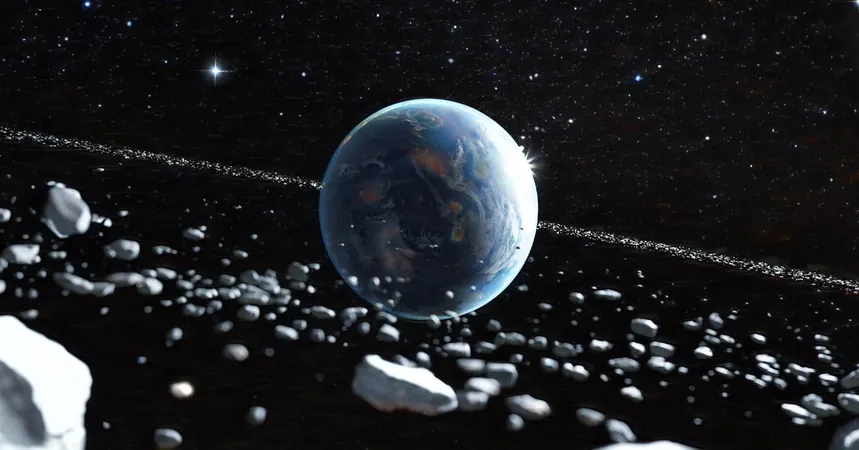
Did Earth Once Have a Stunning Ring Like Saturn? New Research Suggests So!
2024-09-23
The Fascinating Ordovician Period
Imagine gazing up at the sky from Earth 466 million years ago and seeing a magnificent ring stretching across the horizon. According to a groundbreaking new study, this could have been a reality during the Ordovician Period, a time before terrestrial animals roamed the planet.
The Link Between Meteor Events and Asteroid Debris
Recent research published in Earth and Planetary Science Letters draws a fascinating connection between the surge in meteor impact craters from this era and what scientists believe may have been a vast ring of asteroid debris surrounding Earth. Historically, astronomers noted an unusual spike in meteor showers that produced numerous craters and meteorite-laden sediments—a phenomenon known as the Ordovician meteor event. This event was previously attributed to a large asteroid that exploded in the asteroid belt, sending fragments hurtling toward our planet.
A New Perspective from Dr. Andy Tomkins
However, new insights led by Dr. Andy Tomkins, a professor of Earth and planetary sciences at Monash University, propose a stunning alternative: an asteroid that came perilously close to Earth, succumbing to our planet's gravitational pull and breaking apart. This catastrophic breakup could have resulted in debris forming a ring around Earth's equator—a scenario that might have influenced the climate and biodiversity during this tumultuous period.
Geological Evidence and Crater Mapping
Dr. Tomkins shared that his inspiration came from the moons of Mars, Phobos and Deimos, believed to have formed from remnants of a ring around their planet. This led him to wonder whether the geological record might similarly indicate that Earth once had a ring. The research team specifically mapped the locations of 21 Ordovician craters, revealing a striking pattern; instead of a random global distribution, these craters predominantly clustered near the Equator, suggesting a direct link to an equatorial debris ring. "That’s what gave it away," Dr. Tomkins remarked, noting that such a formation is difficult to explain through typical impact processes.
Implications for Earth's Climate
Moreover, the absence of a corresponding spike in cratering events on Mars and the Moon during this same period could imply that this asteroid activity was exclusive to Earth. Notably, the Ordovician meteorites found in Sweden displayed minimal exposure to cosmic radiation, suggesting they fell to Earth shortly after their parent asteroid's disintegration—unlike the older debris from the asteroid belt that shows extended radiation exposure. There’s also speculation around how this ancient ring may have influenced climate patterns. The team posits that the shadow cast by the ring could have contributed to a significant cooling event known as the Hirnantian ice age, which profoundly impacted the evolution of early life on Earth—a hypothesis meriting further investigation.
Mixed Reactions in the Scientific Community
The paper has received mixed reviews in the scientific community. Birger Schmitz, a geology professor at Lund University, lauded the innovative perspective but emphasized the need for more supporting data. Meanwhile, Gretchen Benedix from Curtin University described the study as "tantalizing" but expressed skepticism regarding the connection between the ring and the ice age, highlighting the complexities that still need to be examined.
Looking to the Future
Could this astronomical theory transform our understanding of Earth's history? As scientists continue to explore these ancient pasts, the intriguing possibility of a breathtaking ring lingering in our skies invites both fascination and curiosity. Stay tuned for more updates as we delve deeper into Earth's cosmic mysteries!



 Brasil (PT)
Brasil (PT)
 Canada (EN)
Canada (EN)
 Chile (ES)
Chile (ES)
 España (ES)
España (ES)
 France (FR)
France (FR)
 Hong Kong (EN)
Hong Kong (EN)
 Italia (IT)
Italia (IT)
 日本 (JA)
日本 (JA)
 Magyarország (HU)
Magyarország (HU)
 Norge (NO)
Norge (NO)
 Polska (PL)
Polska (PL)
 Schweiz (DE)
Schweiz (DE)
 Singapore (EN)
Singapore (EN)
 Sverige (SV)
Sverige (SV)
 Suomi (FI)
Suomi (FI)
 Türkiye (TR)
Türkiye (TR)